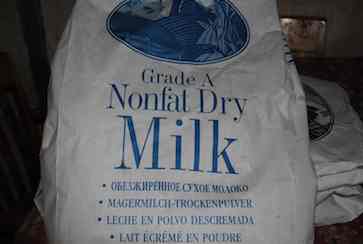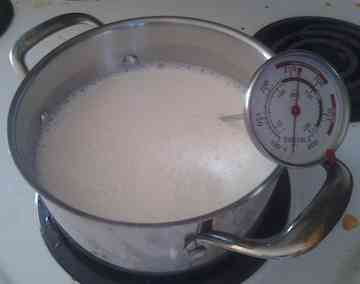Corey Naughton’s new Cheese-making recipe

Little Miss Muffet sat on a tuffet – Eating her curds and whey, – Along came a spider, – who sat down beside her – And inquired as to if she had used Corey’s cheese making recipe …
Now I know what you’re thinking … I’ve been ranting in my recipes how storing oils is difficult and producing your own is not a viable option for many. So how can I come out with a recipe on cheese making while keeping things “long term food storage” friendly?
Well, sit back and relax my baby birds because I’m going to feed you. This recipe will demonstrate how you can make cheese from dehydrated milk.
But first, a word on equipment. As anyone who’s spent a few years off-grid can tell you “Quality equipment means everything”. While cheap equipment can typically get the job done, you’ll quickly find that (a) not having the right tool and (b) not having a quality tool … Will catch up to you. Cheese making is one of those things that really requires quality tools if you wish to get the job done and achieve enjoyable results. Therefore, this article will include an equipment list.
Deviate at your own risk.
Equipment:
Tall thick bottomed pot – The thick bottom will heat more evenly and help protect against burning.
Thermometer – Must have accurate measurement ability from 100f-200f and clip to the side of the pot.
Strainer – A very fine strainer is a must for separating.
Cheese cloth – A good strainer will make this unnecessary but it will still help.
Rubber spatula – Don’t believe those who tell you to use a wooden spoon. I’ll explain why later.
Mixing bowl – Choose one that your strainer fits in nicely.
Whisk – If you’ve mixed dehydrated milk before you know this makes life much easier.
Ingredients:
Dehydrated milk – 2 cups
Water – 4 cups
Distilled vinegar – 1/3 cup
Salt – 1/4 tsp
Seasoning – This will vary by taste but you’ll definitely want some more salt. Basil and oregano go nicely too.
(Optional) Dry cultured buttermilk (see previous article) – 2 tbsp – This will add a little fat and improve texture.
Directions:
1) Place your strainer in your mixing bowl ahead of time. If using cheese cloth lay it into the strainer evenly with overhang.
2) Clip your thermometer onto the side of your pot. The probe may touch the bottom of the pot but must be reasonably submerged into your mixed liquid. It should look something like this after you’ve mixed your ingredients in.
3) Pour your water into the pot and slowly whisk in your dehydrated milk. If you’re using the cultured buttermilk wait until the dehydrated milk is fully dissolved before whisking in. Add salt.
4) Using low-medium heat, SLOWLY bring the temperature up to 175f while stirring regularly.
5) Once you’re reached 175f, pour in your vinegar while stirring. You should notice small curds begin to form almost immediately.
6) Increase your heat (not beyond medium) and raise your temperature to 190f-200f.
Important notes: This is where stirring really becomes a chore. You MUST keep stirring to prevent burning/boiling. This is also the first place where your rubber spatula comes in handy. Use it to drag the bottom and sides of your pot and you’ll have a much easier time. Curds will try to form onto your thermometer probe. Use your spatula to keep curds off your thermometer as they will prevent it from reading properly.
7) Continue stirring while your curds separate from the whey. Do a google image search on “curds and whey” to see what you should be looking for as far as separation.
8) Remove the pot from heat and continue stirring for one minute.
9) Cover your pot with a lid or cheese cloth (keeps out yuckies while allowing it to cool quicker).
10) Go find something else to do for the next hour while the curds and whey cool. How long you allow your curds to sit in the whey will alter; size, texture, and taste … So adjust your cooling times as you see fit for some different variations. Anywhere from 30 minutes to 2 full hours is fine.
11) THOROUGHLY WASH YOUR HANDS. You’ve been doing other things for an hour or so and your hands are dirty! You’re about to handle the cheese and this will pull every speck of yuckies off your hands if they are not VERY clean. You don’t want dirty cheese which tastes like whatever you were doing and spoils faster.
12) Remove the cheese cloth from the top of your pot and SLOWLY pour off the whey through the strainer. (Save the whey!)
13) Once the bulk of the whey has been poured off you can then pour your curds through your strainer (and cheese cloth if you’re using it).
14) This is where your rubber spatula really shines. The bottom and sides of your pot will have a variety of curds sticking to it. Use your rubber spatula to get those last few precious curds out of the pot and into the strainer.

15a) If using cheese cloth: Add salt/seasoning, grab the corners of the cheese cloth, vigorously squeeze out remaining whey.
15b) If using strainer only: Add salt/seasoning, use a spoon to mix curds and press out remaining whey.
16) Allow the curds to sit for 10-30 minutes while the last of the whey evaporates away.
17) Eat fresh and still warm or store in a zip lock bag with all air removed in the fridge. Should stay fresh for about a week.
Going Forward …
Your fresh cheese can be enjoyed in a variety of ways. Sarah likes to sit down with the bag and just pop the curds into her mouth while watching a movie. I like to get a little more creative and use it to cook up some deliciousness like my “Off-Grid Pizza” (recipe is coming)
Off-Grid Pizza before baking
You also must decide what to do with the whey. It can replace water (1:1) in any recipe but it’s particularly nice for dough making. Allowing the whey to sit at room temperature overnight will cause lactic acid to build up and the whey can then be reprocessed to get even more cheese.
However you decide to use your fresh cheese and leftover whey I hope you enjoy it. Vary your times and seasonings to make this recipe your own and have a treat for the whole family. Oh, and did I mention, as dehydrated milk is fat free so is your cheese!






3 Responses
i can’t wait to try this recipe. looks good.
I grew up making cheese with my mom twice a week. This was fun for me to see how someone else would do it. We would take it one step further and press it. My dad made the press out of a simple can, a continuous screw, 2 metal plates with holes in them, and some washers and wing nuts. It worked great. Sometimes my mom would dye the milk. The funnest color she did was purple. Happy Cheese making.
Great idea, thanks for sharing.